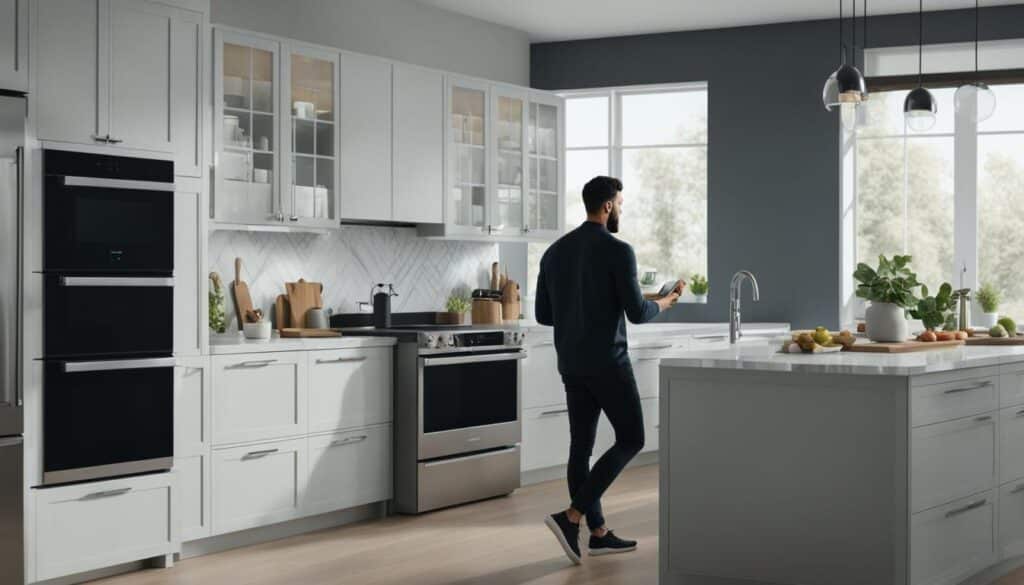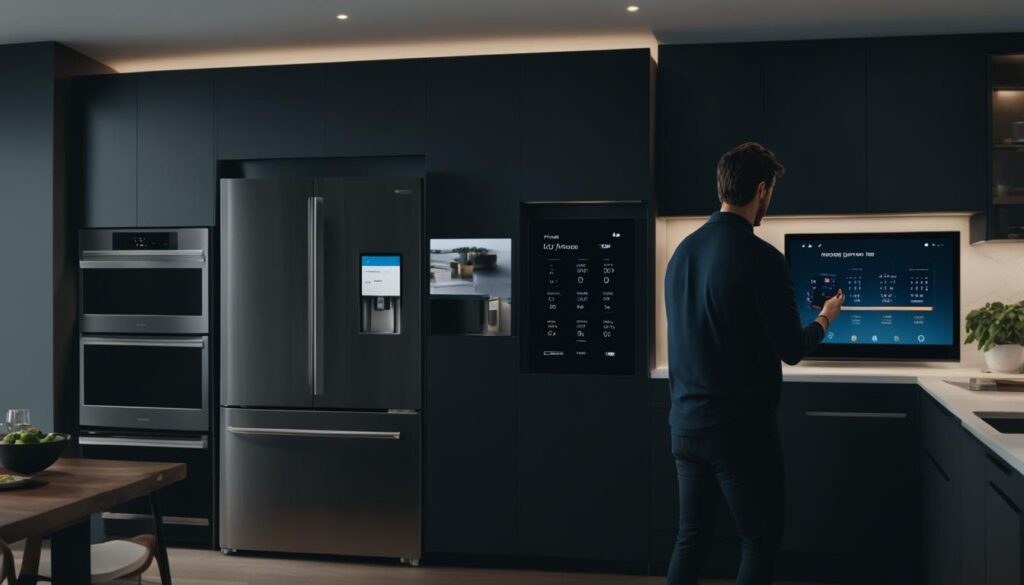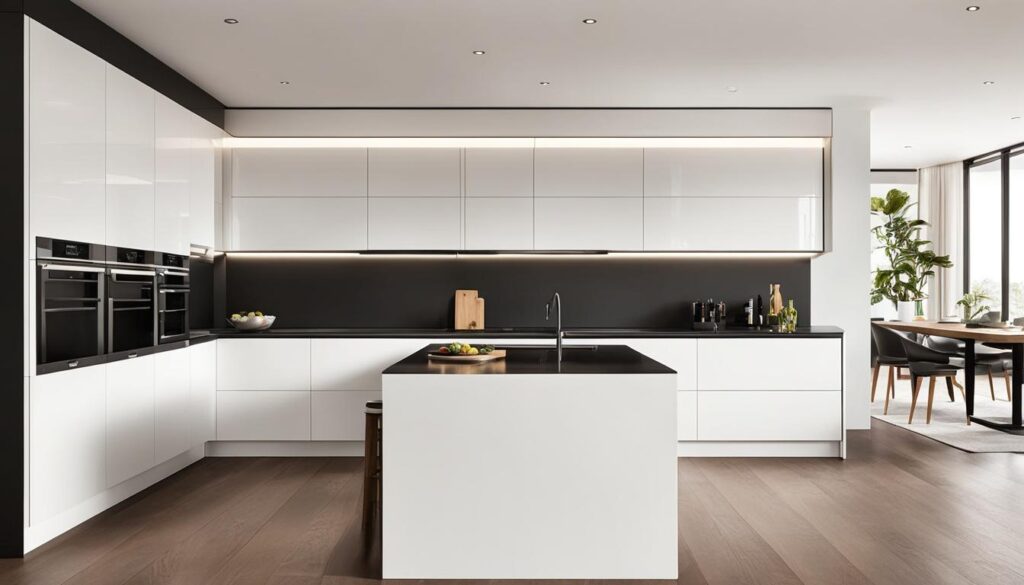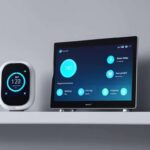Greetings! I’m here to guide you on an exciting journey into the world of smart home technology. In this beginner’s walkthrough, we will explore everything you need to know about integrating smart appliances into your home. Whether you’re a tech enthusiast or just starting to dip your toes into the world of smart devices, this guide will provide you with all the knowledge and confidence you need to transform your home into a smart tech haven.
Table of Contents
Key Takeaways:
- Smart home technology offers convenience, energy efficiency, and enhanced security.
- Consider compatibility and desired features when choosing smart appliances.
- Follow step-by-step instructions for setting up and connecting your devices.
- Integrate smart appliances into your daily routine with automation and voice control.
- Enhance your smart home experience with advanced features and accessories.
Understanding Smart Home Technology
Smart home technology has completely transformed the way we interact with our homes, offering convenience, efficiency, and enhanced security. In this section, we will delve into the concept of smart home technology and its impact on our daily lives. We will explore a variety of smart appliances that are available in the market, including smart thermostats, smart speakers, and smart lighting.
Smart home technology encompasses a range of IoT devices and connected devices that can be controlled and monitored remotely. These devices are designed to make our lives easier and more comfortable. By connecting these devices to a central hub or using a mobile app, you can control them from anywhere in the world, providing unparalleled convenience.
One of the key benefits of integrating smart appliances into your home is energy efficiency. Smart thermostats, for example, can learn your heating and cooling patterns and adjust the temperature accordingly, helping you save on energy costs. Similarly, smart lighting systems can be programmed to turn off when no one is in the room, reducing unnecessary energy consumption.
“Smart home technology enables us to automate everyday tasks and make our homes more efficient and convenient.”
In addition to energy efficiency, smart home technology offers enhanced security features. IoT devices such as smart security cameras and door locks allow you to monitor and control access to your home remotely. You can receive alerts and notifications on your smartphone if any suspicious activity is detected, giving you peace of mind even when you are away.
By integrating smart appliances into your home, you can create a connected ecosystem that simplifies your daily routines, saves you time and energy, and provides a more secure living environment. Whether it’s controlling your home’s temperature, turning on the lights, or playing your favorite music, smart home technology puts you in control of your living space.
Types of Smart Appliances
Let’s take a closer look at some of the popular types of smart appliances:
| Smart Thermostats | Smart Speakers | Smart Lighting |
|---|---|---|
| Allow you to control your home’s temperature remotely and learn your preferences for energy efficiency. | Enable voice control for various tasks, such as playing music, searching the internet, and controlling other smart devices. | Can be programmed to turn on and off automatically, adjust brightness, and even change color. |
These are just a few examples of the wide range of smart appliances available in the market. Each device offers unique features and functionalities that can enhance your lifestyle and make your home smarter.
Now that we have a better understanding of smart home technology and the benefits it offers, let’s move on to the next section and explore how to choose the right smart appliances for your home.
Choosing the Right Smart Appliances for Your Home
When it comes to transforming your home into a smart tech haven, choosing the right smart appliances is essential. From smart thermostats to security cameras and entertainment systems, the options can be overwhelming. In this section, I will guide you through the process of selecting the perfect smart appliances for your home, considering factors like compatibility and features.
Factors to Consider
When choosing smart appliances, compatibility is key. Before making a purchase, ensure that the appliances you are interested in are compatible with your existing devices and smart home ecosystem. Different brands may have their own compatibility requirements and protocols, so it’s important to do your research and choose appliances that seamlessly integrate with your current setup.
Another important factor to consider is the features and functionalities of the smart appliances. Think about what matters most to you and how you envision using these appliances in your daily life. Are you looking for energy-efficient appliances, voice control capabilities, or advanced automation features? Understanding your needs and priorities will help you narrow down your options and choose appliances that align with your lifestyle.
Popular Smart Appliance Recommendations
To give you a head start, here are some popular smart appliances in different categories:
- Smart Kitchen Appliances: Brands like Samsung, LG, and Bosch offer a range of smart refrigerators, ovens, and dishwashers that can revolutionize your cooking and meal prep experience. These appliances often come with features such as Wi-Fi connectivity, intuitive controls, and recipe integration.
- Smart Security Systems: Companies like Ring, Nest, and Arlo provide smart security cameras, video doorbells, and alarm systems that offer enhanced protection for your home. Look for features like motion detection, two-way audio, and remote monitoring capabilities.
- Smart Entertainment Systems: Brands like Sonos, Bose, and Sony offer smart speakers and soundbars that can transform your entertainment setup. These devices often come with voice control, multi-room audio, and integration with popular streaming services.
Remember to consider your specific needs and preferences when choosing smart appliances. What works for one person may not necessarily work for you, so take the time to evaluate your options and make an informed decision.
Now that you have a better understanding of how to choose the right smart appliances, it’s time to move on to the next section, where we will discuss the process of setting up and connecting these appliances to your home network.
Setting up and Connecting Smart Appliances
Now that you have selected your desired smart appliances, it’s time to set them up and connect them to your home network. This step-by-step guide will walk you through the process, ensuring a smooth and effortless integration of your smart devices.
1. Download the necessary apps: Start by identifying the relevant mobile applications for each of your smart appliances. Visit the Apple App Store or Google Play Store and search for the respective app. Download and install the app on your smartphone or tablet.
2. Connect to Wi-Fi: Ensure that your home Wi-Fi network is active and functioning properly. Open the settings on your smartphone or tablet and navigate to the Wi-Fi section. Connect to your home network by selecting the appropriate network name (SSID) and entering the Wi-Fi password, if required.
3. Follow the manufacturer’s instructions: Every smart appliance might have a slightly different setup process. Review the user manual or instructions provided by the manufacturer to understand the specific steps involved in setting up your chosen device.
4. Link devices to a central hub (if applicable): Some smart appliances, such as those from the same brand or ecosystem, can be connected to a central hub for easier management and control. Check if your devices are compatible with a hub, and if so, follow the instructions to link them together for a seamless user experience.
5. Troubleshooting connectivity issues: If you encounter any connectivity issues during the setup process, try the following troubleshooting tips:
• Ensure that your mobile device and smart appliance are within range of your Wi-Fi router.
• Restart your Wi-Fi router and smart appliance.
• Check for any firmware updates for your smart appliance and install them if necessary.
• Verify that you are following the correct setup instructions and have entered the correct credentials.
By following these steps and troubleshooting tips, you will be able to set up and connect your smart appliances to your home network with ease. Once the setup is complete, you can start enjoying the convenience and efficiency that smart home technology brings.

| Smart Appliance | Required App | Compatibility |
|---|---|---|
| Smart Thermostat | Smart Thermostat App | Compatible with popular HVAC systems |
| Smart Speaker | Smart Speaker App | Compatible with voice assistants like Alexa and Google Assistant |
| Smart Lighting | Smart Lighting App | Compatible with various lighting systems |
Integrating Smart Appliances into Your Daily Routine
Now that you have set up and connected your smart appliances, it’s time to seamlessly integrate them into your daily routine. With the automation features available, you can create personalized schedules, routines, and actions for your devices, making your home more efficient and convenient.
Imagine waking up to the aroma of freshly brewed coffee as your smart coffee maker starts brewing at your preferred time. Or arriving home to a perfectly lit and cozy environment as your smart lighting system adjusts to your preset preferences. With automation, these scenarios become a reality.
Creating routines is easy, thanks to the intuitive interfaces of smart home apps. You can group devices based on specific rooms or functions and define actions that happen simultaneously or in sequence. For example, you can set your lights to gradually dim at night, the thermostat to adjust to a comfortable temperature, and your favorite music to start playing, creating a relaxing ambiance.
“Automation allows you to enjoy a seamless smart home experience, with your appliances working together to simplify your daily activities and enhance comfort,” says Sarah Johnson, a smart home enthusiast.
Automation allows you to enjoy a seamless smart home experience, with your appliances working together to simplify your daily activities and enhance comfort.
Voice control is another powerful feature that brings convenience to a whole new level. With virtual assistants like Alexa and Google Assistant, you can control your smart appliances with simple voice commands. Just imagine being able to turn off lights, adjust thermostats, and start your appliances without lifting a finger.
To leverage voice control, make sure your smart appliances are compatible with the virtual assistant of your choice. Set up the necessary connections between your devices and the voice assistant, and you’re ready to go.
Don’t forget that voice control is not limited to just one device. You can have multiple smart speakers or displays throughout your home, allowing you to control your appliances from any room. Whether you’re in the kitchen, living room, or bedroom, your smart home technology is always at your command.
Benefits of Integrating Smart Appliances
Integrating smart appliances into your daily routine offers several benefits:
- Convenience: Control and manage your devices with ease, simplifying tasks and saving time.
- Efficiency: Optimize your energy usage, reducing costs and promoting sustainability.
- Comfort: Customize your living environment to suit your preferences and create a more enjoyable space.
- Security: Enhance the safety and security of your home with features like smart locks, cameras, and alarms.
By leveraging automation and voice control, you can truly unlock the full potential of your smart appliances and create a living space that seamlessly adapts to your needs.

Enhancing Your Smart Home Experience
Now that you have successfully integrated smart appliances into your home, it’s time to take your smart home experience to the next level. In this section, we will explore advanced features and accessories that can enhance your smart home setup, ensuring a seamless and convenient experience. We will delve into the world of smart home hubs, discuss the importance of security features, and touch upon emerging trends in smart home technology.
Centralized Control with Smart Home Hubs
A smart home hub acts as a centralized control point for all your smart devices, allowing you to manage and control them from one place. These hubs provide a user-friendly interface that simplifies the management of your devices, making it easier than ever to adjust settings, create automation routines, and monitor your home’s energy usage.
By utilizing a smart home hub, you can integrate different brands and types of devices, ensuring seamless communication and compatibility. Whether it’s adjusting your thermostat, turning on your lights, or playing your favorite music, a smart home hub puts the power at your fingertips. Some popular smart home hubs include:
- Amazon Echo (Alexa)
- Google Nest Hub
- Apple HomePod
Security Features for Peace of Mind
As smart homes become more prevalent, it’s essential to prioritize the security of your devices and networks. By implementing the right security features, you can protect your smart appliances from potential threats and ensure that your personal data remains secure. Some key security measures to consider include:
- Strong passwords: Use unique, complex passwords for each of your smart devices to prevent unauthorized access.
- Two-factor authentication: Enable two-factor authentication whenever possible to add an extra layer of security to your devices.
- Network segmentation: Separate your smart devices from your main network by creating a separate network specifically for them. This reduces the risk of unauthorized access.
- Regular updates: Keep your devices’ firmware and software up to date to benefit from the latest security patches and enhancements.
By implementing these security features, you can enjoy the convenience of a smart home without compromising on safety.
The Future of Smart Home Technology
The smart home industry is constantly evolving, with new technologies and innovations emerging regularly. As we look to the future, there are exciting developments on the horizon that will further enhance your smart home experience. Some of the trends to keep an eye on include:
“The seamless integration of artificial intelligence (AI) technology into smart home devices will revolutionize the way we interact with our homes. From intelligent voice assistants that anticipate your needs to predictive energy management systems, the future of smart homes promises unparalleled convenience and efficiency.” – Smart Home Magazine
With the rapid advancement of technology, there is no doubt that the future holds even greater possibilities for smart homes.
Conclusion
In conclusion, integrating smart appliances into your home can bring a plethora of benefits, revolutionizing your daily life with increased convenience, efficiency, security, and comfort. By following the comprehensive beginner’s walkthrough provided in this article, you will gain the knowledge and guidance necessary to embark on this exciting journey of smart home integration.
With the ability to control and monitor your appliances remotely, you can effortlessly manage your household tasks without being physically present. Imagine preheating your oven on your way home from work, or turning off the lights downstairs from the comfort of your bed. This level of convenience is made possible through the seamless integration of smart appliances.
In addition, smart home integration offers improved energy efficiency, allowing you to minimize wasted energy and reduce your carbon footprint. By remotely controlling your thermostat or automatically adjusting lighting based on occupancy, you can optimize energy usage and lower your utility bills.
Furthermore, smart appliances contribute to enhanced security measures for your home. With features like motion sensors, door and window sensors, and remote monitoring, you can keep a watchful eye on your property and receive instant alerts in case of any unusual activity or breaches.
So, seize the opportunity to transform your home into a tech haven by integrating smart appliances. Experience the convenience, efficiency, security, and comfort that smart home technology has to offer. By following the steps outlined in this article, you can confidently navigate the world of smart home integration and unlock the full potential of your daily life.
FAQ
What is smart home technology?
Smart home technology refers to the integration of internet-connected devices into your home, allowing you to control and automate various aspects of your home environment. These devices, also known as smart appliances, can be controlled remotely through a smartphone or voice commands, and often feature advanced features and functionalities.
What are some common types of smart appliances?
Some common types of smart appliances include smart thermostats, which allow you to control and schedule your home’s heating and cooling systems; smart speakers, which can play music, answer questions, and control other smart devices; and smart lighting, which can be dimmed or turned on and off remotely.
What are the benefits of integrating smart appliances into my home?
Integrating smart appliances into your home can provide numerous benefits, including increased energy efficiency, convenience, and enhanced security. Smart appliances can help you save money on utility bills by automatically adjusting settings based on occupancy and weather conditions. They can also make your daily routines more efficient and convenient by allowing you to control devices with a simple voice command or through automated routines. Additionally, smart appliances often come with security features that can help protect your home and provide peace of mind.
How do I choose the right smart appliances for my home?
When choosing smart appliances for your home, it’s important to consider factors such as compatibility with your existing devices, the features and functionalities that matter most to you, and your budget. Research different brands and models, read customer reviews, and consider consulting with a professional to ensure you select the best options for your specific needs and preferences.
How do I set up and connect smart appliances?
The setup process may vary depending on the specific smart appliance, but generally, you will need to download the manufacturer’s app, connect the device to your home’s Wi-Fi network, and follow the in-app instructions to complete the setup process. For devices that require a central hub, such as a smart home hub, you will need to connect the devices to the hub as well.
How can I integrate smart appliances into my daily routine?
You can integrate smart appliances into your daily routine by utilizing automation features provided by the devices. For example, you can create routines or schedules that automatically adjust the settings of your smart thermostat, turn on your smart lighting at a specific time, or play your favorite music on your smart speaker every morning. Additionally, you can control your smart appliances through voice commands using virtual assistants like Alexa or Google Assistant.
How can I enhance my smart home experience?
To enhance your smart home experience, you can consider investing in a smart home hub. A smart home hub acts as a centralized control point for all your smart devices, allowing you to manage and control them from a single interface. Additionally, you should prioritize the security of your smart appliances and networks by implementing strong passwords, regularly updating firmware, and using secure Wi-Fi networks.


